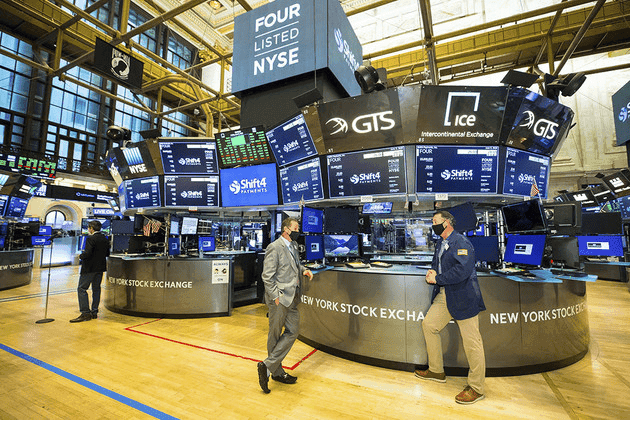Wall Street Ends Choppy Day Lower After Disappointing Jobs Data
In a back-and-forth trading session, Wall Street's main indexes closed lower on Friday as investors analyzed the US jobs report, which revealed slower-than-expected job growth. The market participants also awaited upcoming economic data and corporate earnings announcements. As Per Government Data, the US added the fewest jobs in two and a half years in June, although wage growth remained strong, indicating tight labor market conditions.
Key Highlights
• US job growth slows; wage gains remain strong
• Indexes end with weekly losses
• Levi Strauss shares drop after company cuts outlook
• Rivian shares rally after strong deliveries
• Indexes down: Dow 0.55%, S&P 500 0.29%, Nasdaq 0.13%
Wall Street experienced a turbulent trading session, ending lower as investors reacted to a U.S. jobs report revealing weaker-than-expected growth. The market also eagerly awaited additional economic data and corporate earnings in the coming weeks. Here are the key highlights from the day:
Weaker Job Growth Raises Concerns
According to government data, the United States added the fewest jobs in 2-1/2 years in June, suggesting a slowdown in employment growth. However, strong wage growth indicated persistent tight labor market conditions.
Investor Caution Ahead of Earnings Season
The benchmark S&P 500 (.SPX) initially showed strength throughout the afternoon Friday but experienced a sell-off toward the end of the session. Quincy Krosby, Chief Global Strategist at LPL Financial, explained, "Investors are more cautious going into a very important week with the beginning of earnings season and a very important inflation reading mid-week."
Fed's Perspective on Jobs Report
Josh Jamner, Investment Strategy Analyst at Clear-Bridge Investments, commented on the jobs report, stating, "The jobs report is consistent with what the Fed would like to see. That's not to say the mission is accomplished or the job is done. But continued cooling in the jobs market ultimately will make their lives easier."
Market Performance
On Friday, the Dow Jones Industrial Average (.DJI) declined by 0.55%, or 187.38 points, closing at 33,734.88. The S&P 500 (.SPX) lost 0.29%, or 12.64 points, ending at 4,398.95. The Nasdaq Composite (.IXIC) dropped 0.13%, or 18.33 points, concluding at 13,660.72.
Sector Performance and Weekly Losses
Defensive groups within the S&P 500 experienced the most significant decline, with consumer staples (.SPLRCS) falling 1.3%. Conversely, energy (.SPNY) gained 2.1%, while materials (.SPLRCM) rose 0.9%.
The small-cap Russell 2000 (.RUT) performed well, ending the day with a 1.2% increase. However, major indexes closed the week with losses, contrasting the strong performance observed in the first half of the year. The S&P 500 fell approximately 1.2% for the week, the Dow slid roughly 2%, and the Nasdaq dropped 0.9%.
Anticipated Rate Hike and Inflation Concerns
The Federal Reserve is still widely expected to raise interest rates at its upcoming meeting, following a pause in June, as job growth remains above pre-pandemic levels. Chicago Fed President Austan Goolsbee supported this notion, stating that he does not disagree with his fellow U.S. central bankers who believe that rates will need to rise a couple more times this year to curb excessive inflation.
Company News
In company news, Levi Strauss & Co (LEVI.N) witnessed a significant decline of 7.7% in its shares after the denim clothing maker reduced its annual profit forecast. On the other hand, shares of Rivian Automotive (RIVN.O) surged 14.2% after the electric vehicle manufacturer reported better-than-expected quarterly deliveries. Additionally, U.S.-listed shares of Alibaba gained 8% following news that Chinese authorities would impose a $984 million fine on Ant Group, signifying the end of the affiliate fintech company's long-standing regulatory overhaul.
Market Statistics
Advancing issues outnumbered decliners on the NYSE by a ratio of 2.49-to-1, while on Nasdaq, a 2.00-to-1 ratio favored advancers. The S&P 500 achieved 11 new 52-week highs and five new lows, while the Nasdaq Composite recorded 45 new highs and 63 new lows.
Trading Volume
Approximately 10.3 billion shares were traded on U.S. exchanges, slightly lower than the 11.1 billion daily average over the last 20 sessions.
Conclusion
Wall Street faced a choppy trading day, ultimately closing lower as investors grappled with disappointing job growth data. The upcoming earnings season and inflation reading further contributed to caution among market participants. While the Federal Reserve is still expected to raise interest rates, concerns about inflation and the potential impact on the jobs market continue to dominate market sentiment.











Discussion